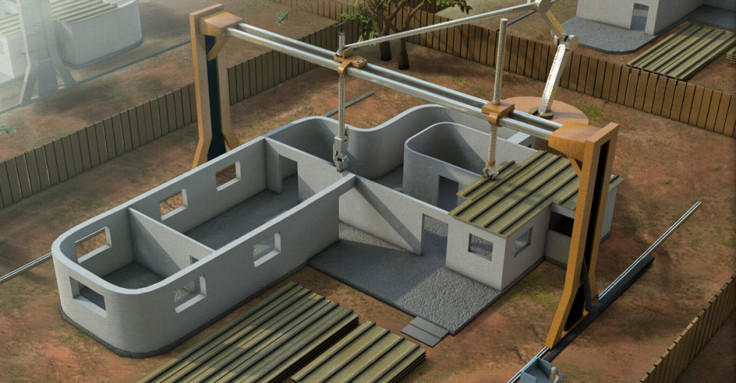3D Printers That Build Entire Houses: Contour Craftings Aims To Print 2,500 Square-Foot-Homes In 20 Hours [Video]

Could 3D printing help solve the world's shelter crises?
At a TED talk in Ojai, Calif., Behrokh Khoshnevis, director of the Manufacturing Engineering Graduate Program at the University of Southern California, said nearly 1 billion people in the world don’t have access to adequate shelter, a situation that breeds poverty, disease, illiteracy, crime and overpopulation. To address this problem, Khoshnevis is developing a process called Contour Crafting to use 3D printing technology to build entire houses.
Khoshnevis said the giant 3D printers his team is developing can build a 2,500-square-foot house in as little as 20 hours. The Contour Crafting 3D printers could even do the electrical work, plumbing, tiling, finishing work and painting.
That may sound too good to be true, but Khoshnevis showed a video demonstrating prototypes of massive 3D printers in action. With a nozzle that secreted a dense, high-performance concrete, the 3D printer erected a wall layer by layer. The walls are hollow to save on materials and make them lighter, but their strength clocks in at about 10,000 psi -- more than traditional housing walls, Khoshnevis said.
The buildings don’t have to be linear, he pointed out. To make the buildings structurally sound as well as beautiful, the 3D printers can print curves.
NASA is currently sponsoring the Contour Crafting project to construct 3D printers that can produce lunar structures. Khoshnevis said his goal with the project is to quickly, safely and more efficiently produce entire neighborhoods in impoverished areas. Since the design of each house could easily be customized on the computers, Contour Crafting can even avoid a nightmare of homogenous track homes.
Khoshnevis estimated that Contour Crafting will save the construction 20 percent to 25 percent in financing and 25 percent to 30 percent in materials. The biggest savings would come in labor, where Contour Crafting would save 45 percent to 55 percent by using 3D printers instead of humans. There would also be fewer CO2 emissions and less energy used.
But wouldn’t replacing manual laborers with 3D printers put thousands or even millions of people out of work? Khoshnevis doesn’t think so, as he compares it to the early 1900s when people feared that agriculture technology would ruin the economy by putting farmers out of work. Less than 1.5 percent of Americans are farmers today, but the world did not come to an end.
Khoshnevis even posits that Countour Crafting will create new jobs, particularly providing women and older workers a chance to work in new areas of construction.
“There will always be better economies resulted from the advancement and utilization of technologies that just make sense,” Khoshnevis said.
© Copyright IBTimes 2024. All rights reserved.






















